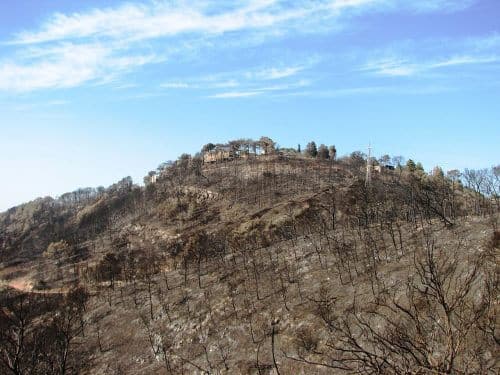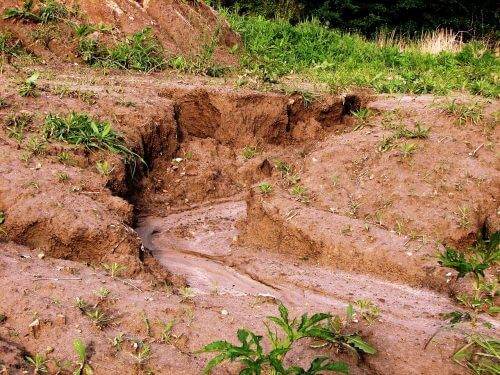Not only houses, trees and animals - the land was also damaged in the great fire. Now, when winter is approaching, the question arises whether these will be blessing rains or whether they will bring with them further erosion and destruction. The experts offer cautious optimism.

By Shahar Shluh, Zveta, Science and Environment News Agency
The fire that raged across the country until a few days ago ignited painful memories of the fire that burned in Carmel in the winter of 2010. At the end of an extremely dry and hot November, it seems that everyone, even the most staunch secularists, prayed for rain - just as we prayed for rain when the fire ravaged the Beit Oren forest six years ago.
Now, when the rain is already here, questions also arise - will there be flooding and landslides in the burned forests and areas, how and if this can be overcome, and is there reason for optimism regarding the restoration?
Water repellent soil
Dr. Gil Eshel, a soil conservation researcher from the Erosion Research Station in the Soil Conservation and Drainage Division - Ministry of Agriculture and Rural Development, explains that fires affect area cells in different ways and to different degrees, depending on the type of soil, the spread of the fire and the intensity of the combustion. We must not forget that the soil has an important role in the natural system and that the soil is a depleting resource that may one day run out, even if it is not visible to the eye.
Following the fire, there are changes in the soil that may change its chemical, physical, mineralogical properties and even the biological system that resides in it. One property that may change is its tendency to repel water, what is known in the professional language as "hydrophobicity". The more hydrophobic the soil, the greater the danger of creating increased runoff - an increased flow of water on the surface of the soil - and subsequent erosion of the soil. The dryness that preceded the fire contributed to the drying of the soil surface and enhanced the potential of water rejection from the soil, which the fire probably only made worse. "If the rain starts at low intensities and causes a slow wetting of the organic material in the soil, it will adsorb water again and lower its level of hydrophobicity," says Eshel, "but if the intensity of the rain is high, already in the first stages of the storm, the fear of conditions that encourage runoff and soil erosion increases Accelerated", meaning - loss of precious land, and fear of floods.
The level of water repellency of the soil depends on its texture, and here the situation actually works in our favor, since most of the fires occurred in places where the soils usually do not become hydrophobic. "Hydrophobicity is more common in coarse-grained soils, for example in loess or clay soils (such as in the Sharon and Negev soils)", Eshel explains. "We usually talk about high hydrophobicity in California, where the grain size is coarse. In our areas, in the mountains, it is less relevant."
The recommendation: do not interfere

Another element of the system that protects the soils is the covering of the soil surface with vegetation, which reduces the creation of surface runoff and soil erosion by protecting the soil from raindrops. "A natural system is protected by vegetation," explains Eshel. "After a fire, there is a decrease in the amount of plant cover, but there is still ash and organic matter on the surface of the ground. However, it should be remembered that everything is relative: a natural area that has become built-up is more problematic in terms of creating runoff and flooding compared to an area that has been burned, because in the built-up area the soil is covered with concrete and asphalt and prevents rainwater from seeping into the subsoil, unlike the areas covered with vegetation."
As evidence of the rapid restoration ability of the soil, Eshel mentions that in Israel it is already known that after the rain everything is green with herbaceous vegetation even after a fire. After a year or two, it is already possible to notice the establishment of a mature plant. "The recommendation is not to interfere or move around there," he says, "so as not to expose the ground and create conditions that encourage surface runoff and soil erosion. Nature has a very good restoration capacity. Ecologists have been saying this for a long time: trees should be cut down where they endanger people, but beyond that the ground should simply be allowed to be covered with grassy vegetation, as happened in Carmel after the fire in 2010. At the end of winter it was already completely green, although there is still time until the full restoration."
One of the common mistakes that occur after a fire due to public pressure is to quickly enter the area with heavy tools to cut down and remove burned trees while the ground is still wet, while embedding culverts that create preferred flow paths and increase runoff damage. In addition to this, the compaction of the soil surface by the passage of vehicles and people not only interferes with the establishment of vegetation, they also increase the risk of the formation of surface runoff and soil erosion. Dr. Eli Argaman, director of the drift research station, explains: "You have to be careful of destruction during the restoration. If they start rebuilding now, the damage following the fire could be greater."
Restoration through a view from above
At the erosion research station, they actively research and develop measures to prevent soil erosion. The erosion causes the loss of the upper soil layer, which has consequences for the soil's fertility and is significant both for farmers and for ecosystems, where the vegetation may be damaged. Through various actions to stabilize the soil, it is possible to slow down the flow, prevent the erosion on the slope and thus speed up the rehabilitation.
In order to spatially investigate the mechanisms for the formation of drift, satellite simulations and aerial photographs are used at the drift research station. The aerial photographs and simulations enable the identification of weathering and soil erosion processes. "The use of satellite simulations makes it possible to monitor the condition of the vegetation," explains Argaman. "We check all the environmental characteristics, such as: surface temperature, radiation, humidity, amount and condition of the plant. This allows us to calculate the evaporation and assess the potential and rate of restoration."
The technology makes it possible to examine over time the rate of change of the burned area, and to learn how the area recovers in terms of vegetation and soil. "This is actually a tool for making decisions for rehabilitation", explains Argaman.
In the meantime, for the curious who want to see the burned forests, for those who wish to collect fallen trunks and for those with good intentions whose path will be speeded up, the experts at the erosion research station recommend watching from a distance - so as not to interfere with the natural restoration processes.

One response
- There is no need to "go in with heavy tools" to clean the area of charred trunks,
It is possible, possible and desirable to remove charred trunks (with a pen and carefully) with the help of horses,
- despite the knowledge that the "leaders of the fire" are pines
There was not enough thinning of pine sprouts (after the fire in Carmel),
It is appropriate that this time the pine sprouts be thinned,
And in their place will be planted oaks, bats, carobs and more...
- The arsonists should be severely punished and it doesn't matter
If it is "nationalist" arson, negligence, evil or stupidity...